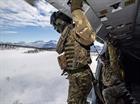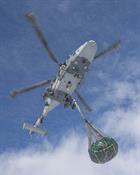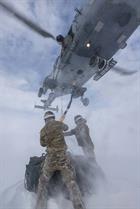Royal Marines’ helicopters complete winter training in Norway
The wings of the Royal Marines are warming up having completed their stint in the Arctic for 2023.
Helicopters of the Commando Helicopter Force decamped from their home in Somerset to deep inside the Arctic Circle: the Norwegian Air Base at Bardufoss.
They deploy every winter to the High North, ensuring they can support the Royal Marines – the nation’s cold weather warfare specialists – alongside Norwegian forces and other NATO allies in the event of an emergency.
The force operates two helicopters: large Merlins for moving substantial numbers of troops and kit around, and smaller, more manoeuvrable Wildcats which perform a myriad of duties on and above the battlefield.
Wildcats are small, light and foldable enough to be moved by RAF transporter.
But with transport space at a premium this winter due to other operations and commitments – notably the RAF delivering aid to Turkey after the terrible earthquake – the Wildcats flew up to Bardufoss instead.
That meant a journey of more than 1,400 miles from the helicopters’ home at RNAS Yeovilton – in legs of two hours or so at a time, hopping from airfield to airfield through England, Scotland, the Shetlands and then across the North Sea to Norway, then up the west coast for a good 700 miles to their destination.
While Wildcat is fast and nimble thanks to being relatively lightweight, it also means it must avoid clouds in Norway where the threat of icing up is much greater than in more temperate UK skies.
Coupled with the ever-changing nature of weather in Norway, such environmental factors place higher demands on the aircrew than when in the UK.
Thanks to frequent bad weather, a journey which should have taken the fliers three days… took them eight.
The goal of Clockwork is to ensure Arctic rookies are able to live/fly/maintain/fight in this harshest of environments (temperatures of -30C at times, or lower) by day or night, so that can support commandos and their allies in most circumstances.
“Operating helicopters from an ice and snow covered landscape with the temperature dipping to the low -20s is challenging for all squadron personnel,” said Lieutenant Paul Smalley, Training Officer of 847 Naval Air Squadron which operates the battlefield Wildcat.
“Pilots need regular exposure to what we call the ‘Degraded Visual Environment’ presented by the snow covered landscape in Norway in order to maintain the skills required to operate their helicopter in the harshest of environments.”
The Wildcats can find themselves acting as reconnaissance, moving personnel and kit around, calling in air, artillery and naval gunfire strikes, and gathering intelligence among other tasks.
To earn their Environmental Qualification, aircrew most complete a series of assessments covering mountain flying, cross-country navigation, and flying in pairs.
The landscape around Bardufoss is especially suited to Arctic/mountain training, with Istind rising 4,900ft just three miles south of the airfield.
Its impressive shape looms over Bardufoss and hides the low Arctic sunlight for much of the morning. As for the surrounding fjords and valleys where the Royal Marines and amphibious ships conduct their winter training, they provide a challenging environment for safe navigation, where the difficulties of poor radio communications, power lines and inclement weather all place extra burdens on aircrew.
The bad weather which dogged the squadron flying out to Norway decided to stick around, but thanks to a concerted effort by fliers and engineers/technicians alike, the squadron achieved a record number of sorties/flying time in a restricted period, ensuring four new pilots are now trained in Arctic operations, alongside a new instructor.
Among those visiting the squadron were Norway’s Crown Prince, Prince Haakon, Norway’s Chief of Defence Staff General Eirik Kristoffersen, and the Commandant General Royal Marines, General Gwyn Jenkins.
As the deployment to Norway drew to a close, the weather brightened up considerably, allowing for more challenging training, notably ferrying supplies to remote locations in the field – slung in giant sacks beneath the helicopter: in this case, a large 300kg truck tyre.
The snow cloud builds significantly as the helicopter approaches for both the pickup and the drop-off, so the front and rear crews in the helicopter have to work seamlessly together to avoid hitting or injuring the Mobile Air Operations Team, the ground crew responsible for attaching the strop to the load.
Clockwork runs side-by-side with – but separate from – the Royal Marines’ annual winter deployment, this year named Joint Viking. The emphasis is getting 847’s personnel Arctic trained… but if there’s time and opportunity, the fliers will join in to provide support.
Lieutenant Mike Pengelly, normally 847’s warfare instructor, swapped the skies for the seas and spent five days aboard the UK’s amphibious flagship HMS Albion, advising on the scope of aviation support available to the Royal Marines of Yankee Company from Arbroath’s 45 Commando, the troops on the ground.
“Overall Operation Clockwork 23 has been a challenging but rewarding deployment and shown that the squadron always comes together to face adversity and produce a solid output,” said Captain Ralph Whyte, an Army Air Corps officer on exchange with 847 Squadron.
By the time the deployment ended, missions to support Turkey’s earthquake victims had tailed off, making transports available to bring the Wildcats home directly.








